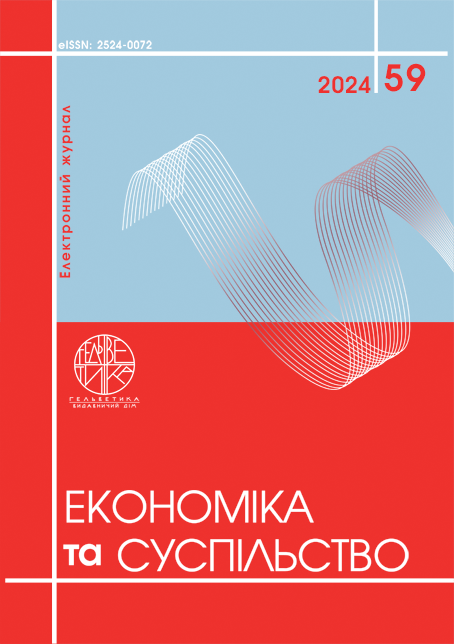WOMEN’S REPRESENTATION IN THE MIDDLE CLASS
Abstract
The article is devoted to topical issues of the role of the middle class in social development. It also focuses on approaches of determining middle class’s quantitative classification criteria, the evolution of its interpretation from the traditional (old) to the new middle class. Among the main criteria of belonging to the middle class, it is proposed to distinguish the following: material factors (current income, level of property security), non-material factors (education, intellectual potential, professional and qualification status, level of complexity of professional activity), non-economic factors (free time and quality of leisure time). The role of the middle class as a bearer of democratic values and a guarantor of political freedoms is emphasized. Special attention is paid to the representation of women in the structure of the middle class. It is substantiated that despite the achievements of women in career and public life, their role in the middle class remains understudied. The impact of the ‘fatherhood effect’ on women’s careers has been studied. It has been proven that women perform a greater amount of non-market activities than men (raising children, various housework, caring for sick family members and the elderly, etc.), which is invisible for national accounts and accounting, and therefore has no market value. Proposals have been formulated to expand ideas about women’s ‘invisible work’ and its recognition in society. Two groups of factors ‒ social and psychological ‒ are singled out, which explain the low representation of women in the middle class. The problem of the glass ceiling is outlined as a phenomenon that prevents women from developing in the professional and political spheres. It is substantiated that stereotypes about the division of responsibilities between men and women affect the representation of women in the middle class, and the need to assess the value of housework and recognize its contribution to social development is also indicated. The influence of gender stereotypes on the representation of women in politics is analyzed, and the clustering of women in humanitarian professions is highlighted. It is argued that in wartime Ukrainian women are the most active representatives of the middle class, which has important consequences for social development.
References
Лібанова Е., Черенько Л., Василєв О., Реут А. Населення із середніми доходами як основа для формування середнього класу в Україні. Національна безпека і оборона. 2014. № 1-2 (144-145). С. 79¬96.
Beneria L. Conceptualizing the labor force: The underestimation of Women's economic activities. The Journal of Development Studies. 1981. № 17(3). Р.10¬28.
Waring M. If women counted: A new feminist economics. Harper & Row. 1990. URL: http://www.roiw.org/1992/237.pdf (дата звернення 13.12.2023).
Goldin C. The Quiet Revolution That Transformed Women’s Employment, Education, and Family. The American Economic Review. 2006. Vol. 96. № 2. P. 1¬21.
Красота О. Середній клас в Україні: сутність та класифікаційні ознаки. Вісник Київського національного університету імені Тараса Шевченка. Серія «Економіка». 2011. Вип. 121-122. С. 76¬81.
Державна служба статистики України: Самооцінка домогосподарствами України рівня своїх доходів. 2020 р. URL: https://ukrstat.gov.ua/druk/publicat/kat_u/2021/zb/07/zb_sdrsd_20.pdf (дата звернення: 16.02.2024).
Національний банк України. Інфляційний звіт. Жовтень 2023 року. URL: https://bank.gov.ua/admin_uploads/article/IR_2023-Q4.pdf?v=5 (дата звернення: 16.02.2024).
Красота О. В, Панова Л. І. А. Феміністична економіка як складова інклюзивного суспільного розвитку. Проблеми сучасних трансформацій. Серія: економіка та управління. 2023. №7. DOI: https://doi.org/10.54929/2786-5738-2023-7-01-02
Official website The Nobel Prize. URL: https://www.nobelprize.org/prizes/economic-sciences/2023/press-release/ (дата звернення: 19.02.2024).
The surprising reason why lesbians get paid more than straight women. URL: https://www.washingtonpost.com/news/wonk/wp/2016/02/25/the-surprising-reason-why-lesbians-get-paid-more-than-straight-women/ (Дата звернення: 25.12.2023)
Офіційний веб-сайт Work.ua. URL: https://www.work.ua/salary/ (дата звернення: 23.02.2024).
Можливості жінок в Україні. Соціологічне дослідження. 2023. URL: https://ratinggroup.ua/files/ratinggroup/reg_files/rl_gender_issues_062023.pdf (дата звернення: 20.02.2024).
Стратегія впровадження гендерної рівності у сфері освіти до 2030 року : Розпорядження КМ України від 20.12.2022 р. № 1163-р. URL: https://zakon.rada.gov.ua/laws/show/1163-2022-%D1%80#Text (дата звернення: 21.02.2024).
Libanova E., Cherenʹko L., Vasylyev O., Reut A. (2014) Naselennya iz serednimy dokhodamy yak osnova dlya formuvannya serednʹoho klasu v Ukrayini [Population with average incomes as a basis for the formation of the middle class in Ukraine]. Natsionalʹna bezpeka i oborona, No 1-2 (144-145), рр. 79¬96. (in Ukrainian)
Beneria L. (1981) Conceptualizing the labor force: The underestimation of Women's economic activities. The Journal of Development Studies, No 17(3), рр.10¬28.
Waring M. (1990) If women counted: A new feminist economics. Harper & Row. Available at: http://www.roiw.org/1992/237.pdf (accessed December 13, 2024).
Goldin C. (2006) The Quiet Revolution That Transformed Women’s Employment, Education, and Family. The American Economic Review, Vol. 96, No 2, рр. 1¬21.
Krasota O. (2011) Seredniy klas v Ukrayini: sutnistʹ ta klasyfikatsiyni oznaky [The middle class in Ukraine: essence and classification features]. Visnyk Kyyivsʹkoho natsionalʹnoho universytetu imeni Tarasa Shevchenka. Seriya «Ekonomika», No 121-122, рр. 76¬81. (in Ukrainian)
Derzhavna sluzhba statystyky Ukrayiny: Samootsinka domohospodarstvamy Ukrayiny rivnya svoyikh dokhodiv [State Statistics Service of Ukraine: Self-assessment by Ukrainian households of their income level]. Available at: https://ukrstat.gov.ua/druk/publicat/kat_u/2021/zb/07/zb_sdrsd_20.pdf (accessed February 16, 2024) (in Ukrainian)
Natsionalʹnyy bank Ukrayiny. Inflyatsiynyy zvit-2023 [National Bank of Ukraine. Inflation report-2023]. Available at: https://bank.gov.ua/admin_uploads/article/IR_2023-Q4.pdf?v=5 (accessed February 16, 2024) (in Ukrainian)
Krasota O., Panova L.I. (2023) Feministychna ekonomika yak skladova inklyuzyvnoho suspilʹnoho rozvytku [Feminist Economics as a Component of Inclusive Social Development] Problemy suchasnykh transformatsiy. Seriya: ekonomika ta upravlinnya, No 7. DOI: https://doi.org/10.54929/2786-5738-2023-7-01-02 (in Ukrainian)
Official website The Nobel Prize. Available at: https://www.nobelprize.org/prizes/economic-sciences/2023/press-release/ (accessed February 19, 2024).
The surprising reason why lesbians get paid more than straight women. Available at: https://www.washingtonpost.com/news/wonk/wp/2016/02/25/the-surprising-reason-why-lesbians-get-paid-more-than-straight-women/ (accessed December 25, 2024).
Official website Work.ua. Available at: https://www.work.ua/salary/ (accessed February 23, 2024) (in Ukrainian)
Mozhlyvosti zhinok v Ukrayini. Sotsiolohichne doslidzhennya-2023 [Opportunities for women in Ukraine. Sociological research-2023]. Available at: https://ratinggroup.ua/files/ratinggroup/reg_files/rl_gender_issues_062023.pdf/ (accessed February 20, 2024) (in Ukrainian)
Stratehiya vprovadzhennya hendernoyi rivnosti u sferi osvity do 2030 roku : Rozporyadzhennya KM Ukrayiny vid 20.12.2022 r. № 1163-r. [Strategy for implementation of gender equality in the field of education until 2030: Order of the CM of Ukraine dated 12.20.2022 No 1163]. Available at: https://zakon.rada.gov.ua/laws/show/1163-2022-%D1%80#Text (accessed February 21, 2024) (in Ukrainian)

This work is licensed under a Creative Commons Attribution 4.0 International License.


